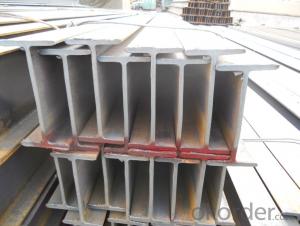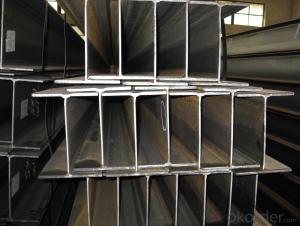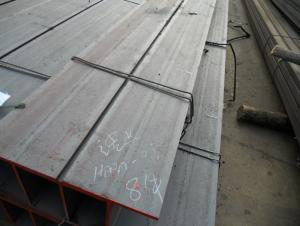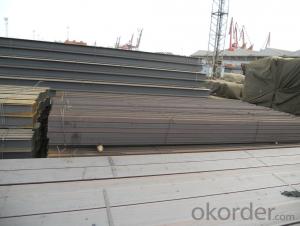Structural Steel H Beam
- Loading Port:
- China Main Port
- Payment Terms:
- TT or LC
- Min Order Qty:
- 100MT m.t.
- Supply Capability:
- 10000MT m.t./month
OKorder Service Pledge
OKorder Financial Service
You Might Also Like
Specifications of Hot Rolled Structural Steel H Beam
1. Standard: GB700-88, Q235B2.
2. Grade: Q235, SS400 or Equivalent
3. Length: 6m,10m, 12m as following table
4. Invoicing on theoretical weight or actual weight as customer request
5.Payment: TT or L/C
6. Sizes:
SIZE(mm) | DIMENSION(kg/m) |
100*100 | 16.9 |
125*125 | 23.6 |
150*75 | 14 |
150*150 | 31.1 |
148*100 | 20.7 |
198*99 | 17.8 |
200*100 | 20.9 |
248*124 | 25.1 |
250*125 | 29 |
Usage & Applications of Hot Rolled Structural Steel H Beam
Commercial building structure ;Pre-engineered buildings; Machinery support structure; Prefabricated structure; Medium scale bridges; Ship-building structure. etc.
Packaging & Delivery of Hot Rolled Structural Steel H Beam
1. Packing: it is nude packed in bundles by steel wire rod
2. Bundle weight: not more than 3.5MT for bulk vessel; less than 3 MT for container load
3. Marks:
Color marking: There will be color marking on both end of the bundle for the cargo delivered by bulk vessel. That makes it easily to distinguish at the destination port.
Tag mark: there will be tag mark tied up on the bundles. The information usually including supplier logo and name, product name, made in China, shipping marks and other information request by the customer.
If loading by container the marking is not needed, but we will prepare it as customer request.
4. Transportation: the goods are delivered by truck from mill to loading port, the maximum quantity can be loaded is around 40MTs by each truck. If the order quantity cannot reach the full truck loaded, the transportation cost per ton will be little higher than full load.
5. Delivered by container or bulk vessel
Production flow of Hot Rolled Structural Steel H Beam
Material prepare (billet) —heat up—rough rolling—precision rolling—cooling—packing—storage and transportation

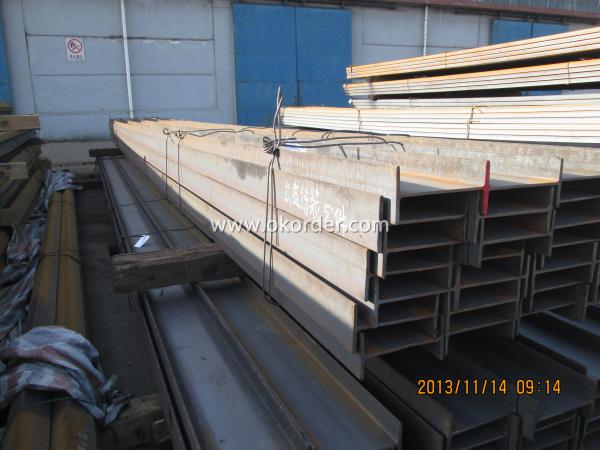
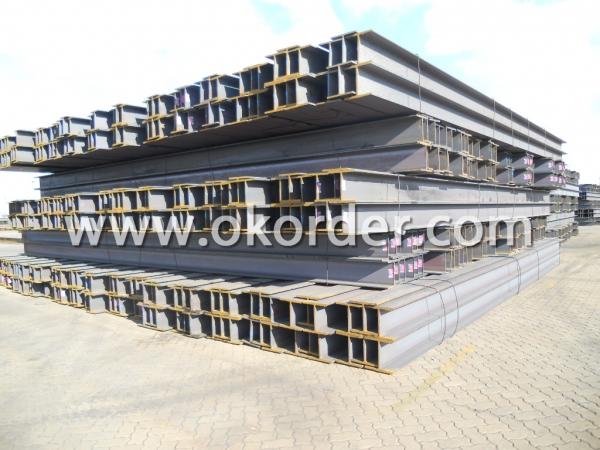
- Q:How do steel H-beams resist bending and deflection?
- Steel H-beams resist bending and deflection due to their unique shape and material properties. The horizontal flanges and vertical web of the H-beam design distribute the applied load evenly, allowing it to bear significant weight without significant bending. Additionally, the high tensile strength of steel ensures structural integrity and minimizes deflection under heavy loads.
- Q:Can steel H-beams be used for supporting outdoor signage or billboards?
- Yes, steel H-beams can be used for supporting outdoor signage or billboards. Steel H-beams are typically used in construction for their strength and durability, making them suitable for supporting heavy structures such as billboards. The H-shape of the beam provides excellent load-bearing capacity and resistance to bending or twisting forces. Additionally, steel H-beams can withstand harsh weather conditions and are often galvanized or coated to protect against corrosion. Overall, steel H-beams are a popular choice for supporting outdoor signage and billboards due to their strength, durability, and ability to withstand outdoor elements.
- Q:What are the different fire protection methods for steel H-beams?
- There are several fire protection methods available for steel H-beams to ensure their structural integrity and prevent them from collapsing during a fire. These methods include: 1. Intumescent Coatings: Intumescent coatings are applied to the surface of the steel beams. When exposed to high temperatures, these coatings expand and form a thick insulating char layer, which protects the steel from heat and slows down its temperature rise. 2. Cementitious Coatings: Cementitious coatings are commonly used for fire protection in steel structures. These coatings consist of a mixture of cement, aggregates, and fibers. They provide a barrier against heat transfer and can withstand high temperatures. 3. Fireproofing Sprays: Fireproofing sprays are a cost-effective method for protecting steel beams. These sprays typically contain a combination of fire-resistant materials and are applied as a thick layer onto the beams. The spray forms an insulating barrier that delays the transfer of heat to the steel. 4. Encasement with Concrete: Another method is to encase the steel H-beams in concrete. This provides excellent fire protection as concrete has a high fire resistance. The concrete acts as a thermal barrier and prevents the steel from reaching critical temperatures. 5. Gypsum Board Encasement: Gypsum board encasement involves covering the steel beams with multiple layers of gypsum board. These boards are fire-resistant and provide a protective covering for the steel. This method is commonly used in buildings where aesthetics are important. It is important to note that the choice of fire protection method depends on factors such as the fire rating requirements, architectural design, and budget. Consulting with fire protection experts and complying with local building codes and regulations is crucial to ensure the appropriate fire protection method is chosen for steel H-beams.
- Q:How do Steel H-Beams perform in terms of sound insulation?
- When it comes to sound insulation, steel H-Beams, which are frequently utilized in construction, do not offer considerable properties in this regard. The main purpose of steel H-beams, due to their structural design and material composition, is to bear loads rather than provide soundproofing. For effective sound insulation, specific soundproofing materials like acoustic panels, insulation batts, or resilient channels are typically employed. As a result, if sound insulation is a priority, additional measures like these should be taken in conjunction with the use of steel H-beams.
- Q:Can steel H-beams be used for manufacturing facilities?
- Manufacturing facilities can indeed utilize steel H-beams. These beams are commonly employed in the construction industry for a range of purposes, including manufacturing facilities. With their exceptional strength, durability, and load-bearing capabilities, steel H-beams are well-suited for supporting the weight of heavy machinery, equipment, and structures within manufacturing plants. Moreover, H-beams offer a robust framework that can be easily fabricated and installed, making them an excellent option for constructing manufacturing facilities that necessitate expansive open spaces and wide spans. Furthermore, steel H-beams possess the capacity to endure high temperatures, rendering them appropriate for industries involving heat-intensive processes. In summary, steel H-beams are an adaptable and dependable choice for constructing manufacturing facilities, thanks to their structural integrity and capacity to handle substantial loads.
- Q:What are the factors that affect the cost of steel H-beams?
- There are several factors that can affect the cost of steel H-beams: 1. Raw material costs: The cost of the raw materials used to manufacture steel H-beams, such as iron ore and coal, can have a significant impact on the overall cost. Fluctuations in the prices of these materials, influenced by factors like supply and demand, can directly affect the cost of producing steel H-beams. 2. Manufacturing process: The method used to manufacture steel H-beams can also impact their cost. Different manufacturing processes, such as hot-rolling or cold-forming, require varying levels of energy, labor, and equipment, which can affect the overall cost. 3. Size and weight: The size and weight of the steel H-beams can impact the cost. Larger and heavier beams require more raw material and may require additional handling and transportation costs, which can increase the overall price. 4. Market demand: The demand for steel H-beams can also affect their cost. If there is a high demand for these beams, prices may increase due to limited supply. Conversely, if the demand is low, prices may be lower as manufacturers compete for customers. 5. Trade policies and international market conditions: Trade policies and international market conditions can also impact the cost of steel H-beams. Factors such as tariffs, import restrictions, and currency exchange rates can affect the cost of raw materials and the overall cost of production, which in turn can impact the final price of the beams. 6. Manufacturing location: The geographical location of the manufacturing facility can also play a role in the cost of steel H-beams. Different regions may have varying labor costs, energy costs, and transportation costs, all of which can affect the final price of the beams. 7. Quality and specifications: The quality and specifications of the steel H-beams can also influence their cost. Higher quality beams that meet stricter standards and specifications may command a higher price compared to lower quality beams. Overall, the cost of steel H-beams is influenced by various factors, including raw material costs, manufacturing process, size and weight, market demand, trade policies, manufacturing location, and quality and specifications. Understanding these factors can help buyers and sellers make informed decisions and negotiate prices effectively.
- Q:How do steel H-beams contribute to daylighting in buildings?
- Steel H-beams play a crucial role in daylighting in buildings by providing structural support while allowing for larger and more expansive windows. Daylighting refers to the use of natural light to illuminate the interior spaces of a building, reducing the need for artificial lighting and creating a more sustainable and pleasant environment. With their strong load-bearing capabilities, steel H-beams can span long distances and support heavy loads, making it possible to have larger window openings. These windows can be strategically placed on exterior walls or even in the roof, allowing natural light to flood into the building's interior. The use of steel H-beams in construction also enables architects to design buildings with open floor plans and soaring ceilings. This architectural freedom allows for the creation of atriums, skylights, and other light wells that further enhance daylight penetration. Moreover, steel H-beams are incredibly durable and resistant to deformation, ensuring that the structural integrity of the building is maintained while maximizing the amount of natural light that enters the space. This is especially important in areas prone to earthquakes or high winds. In addition to their structural benefits, steel H-beams are versatile in terms of design and aesthetics. They can be incorporated into various architectural styles, allowing for innovative and visually appealing building designs that prioritize daylighting. Overall, steel H-beams contribute significantly to daylighting in buildings by providing the necessary strength and support for larger windows, allowing for creative architectural designs, and ensuring the durability of the structure. By harnessing natural light, buildings can reduce energy consumption, improve occupants' well-being, and create more sustainable and inviting spaces.
- Q:How long do steel H-beams last?
- Steel H-beams have a long lifespan and can last for several decades, often exceeding 50 years, provided they are properly maintained and not subjected to excessive corrosion or structural damage.
- Q:Can steel H-beams be used for utility poles?
- No, steel H-beams are not typically used for utility poles. Utility poles are usually made of wood or concrete due to their durability, strength, and cost-effectiveness. Steel H-beams are more commonly used in construction for supporting heavy loads in buildings and bridges.
- Q:H how long is the length of the steel section?
- The average length is 12m!!!!!!!!But this H steel can be negotiated with manufacturers.According to the required length, but generally require a long time to go to docking.
1. Manufacturer Overview |
|
|---|---|
| Location | Tangshan, China |
| Year Established | 2007 |
| Annual Output Value | Above US$ 80 Million |
| Main Markets | Mid East; Southeast aisa; korea |
| Company Certifications | |
2. Manufacturer Certificates |
|
|---|---|
| a) Certification Name | |
| Range | |
| Reference | |
| Validity Period | |
3. Manufacturer Capability |
|
|---|---|
| a)Trade Capacity | |
| Nearest Port | Tianjin; |
| Export Percentage | 20% - 25% |
| No.of Employees in Trade Department | 11-15 People |
| Language Spoken: | English; Chinese |
| b)Factory Information | |
| Factory Size: | Above 75,000 square meters |
| No. of Production Lines | 1 |
| Contract Manufacturing | OEM Service Offered; |
| Product Price Range | Average |
Send your message to us
Structural Steel H Beam
- Loading Port:
- China Main Port
- Payment Terms:
- TT or LC
- Min Order Qty:
- 100MT m.t.
- Supply Capability:
- 10000MT m.t./month
OKorder Service Pledge
OKorder Financial Service
Similar products
New products
Hot products
Hot Searches
Related keywords











